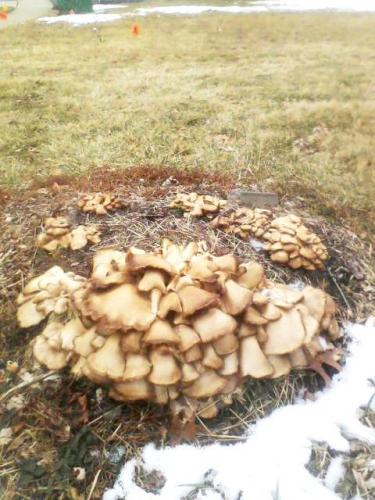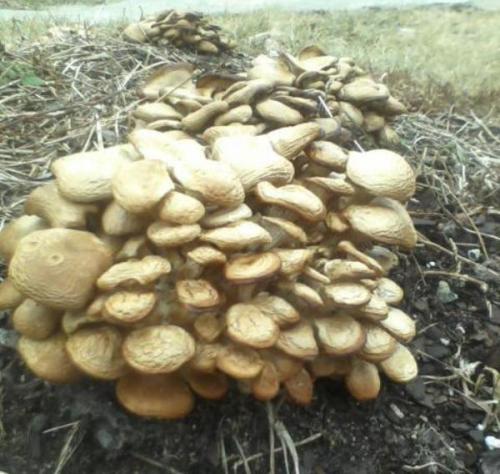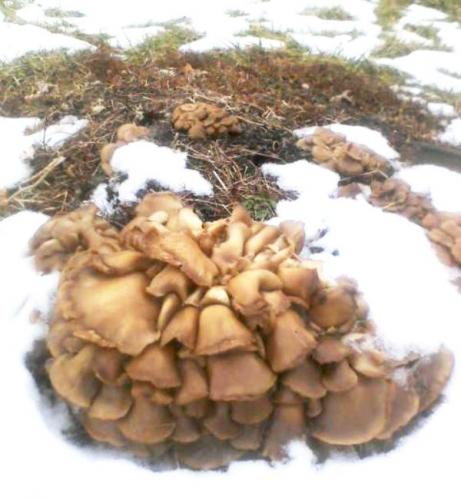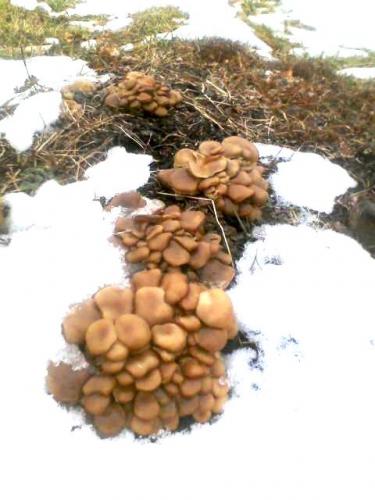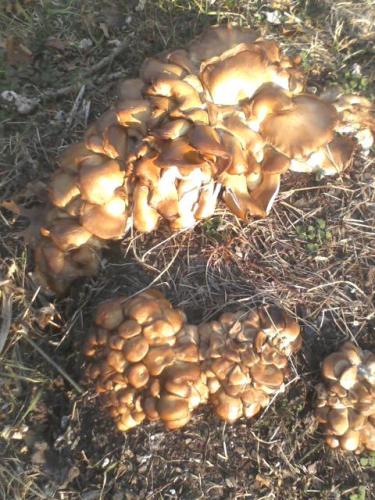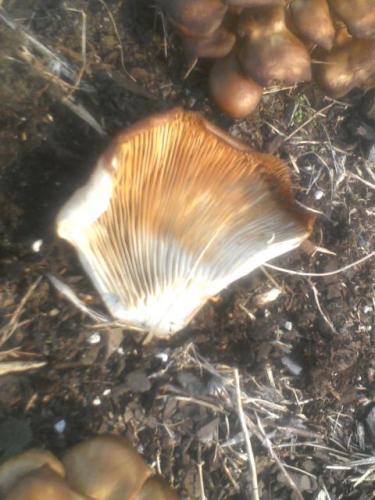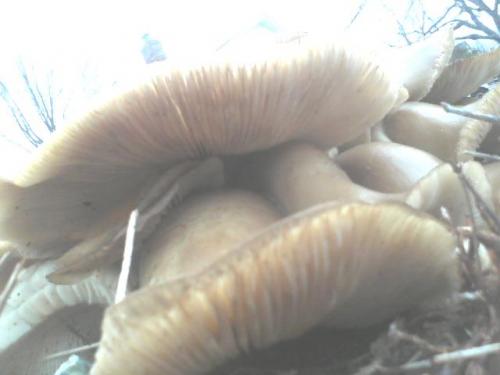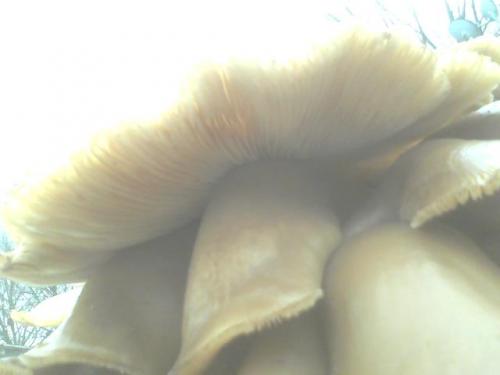

augur
Members-
Posts
12 -
Joined
-
Last visited
Profile Information
-
Location
Ewing, NJ
augur's Achievements
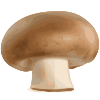
Agaricus Newbie (1/5)
-
Hi Dave - I took that photo from about 4 feet away. The caps in the foreground are perhaps 3 to 5 inches in diameter. The smaller ones in the background are perhaps 1 1/2 to 2 inches in diameter. I agree, they don't look like the pictures of Panellus stipticus that I see online. And they certainly aren't bioluminescent (although that I would like to see). I see online that one name for Panellus stipticus is the "bitter oyster". So is P. stipticus an oyster mushroom or not?
-
Hi Dave - Well, the NJMA never got back to me. Sorry about that. Of some interest, to me at least, is that after being buried under and re-emerging from snow several more times, these mushrooms have now thawed out, and yet somehow are apparently still alive. And it's been 2 months since I first discovered them, already full grown. I don't get it.
-
Is SOMA an acronym for something? Great photos, by the way.
-
Hi Dave - Three days ago, on Wednesday, I spoke to the president of the New Jesey Mycological Association on the phone, and at her request, I emailed her my observations and photos of these mushrooms, as well as a link to this thread. She had said that she would send them on to NJMA's mushroom identifiers. Presumably I'll hear back from them at some point, and when I do, I'll post their opinion to this thread. I just wanted to let you know that I had followed up on your suggestion to contact them. Thanks again.
-
You're right. In that photo, as it initially appeared on my computer monitor, those gills were visible only as dark shadows. Upon hearing that you could see gills where I could see only shadows, I adjusted the photo's brightness, midtones and contrast, "zoomed in" on the gills, and increased the size of the shot. Then I was able to clearly see these gills. And as you observed, they have a decurrent appearance. (See the attachment to this post, "small caps 02-14-2015 detail.jpg".) There is one large cluster of mushrooms with large caps, and five smaller clusters of mushrooms with smaller caps. Judging by everything I've seen so far, all the fruit bodies (caps) in any given cluster share a common, "fleshy mass" from which they are growing. I haven't seen any individual fruit bodies that are growing directly out of the soil. Incidentally, each cluster's fleshy mass is ABOVE the soil, and appears to consist of trama tissue identical to that of the cap context, rather than mycelium comprised of discerible hyphae. Doubtless each of these fleshy masses is itself growing out of a subterranean mycelium, but admittedly I haven't actually observed this to be so, since I haven't dug up any of the clusters. I'll do so as soon as the ground thaws out. Thanks for the tip. I've found them online, and I will consult them and report back to this forum whatever I find out.
-
I don't understand. I don't see any gills at all in either of those two photos. Also, I believe it can be seen fairly clearly in the last two of the four photos I included with my original post on January 22, that the gills were simply attached in a straight line directly to the common, fleshy mass from which all the mushrooms in a given cluster grew. In other words, the gill attachment was not decurrent, adnate, adnexed, free, etc. Actually, I'm also a little confused about terminology. Everything I've read about gill attachment is with reference to attachment to a stipe, and as I have said, and thought was illustrated by the last two of the four photos I included with my original post on January 22, that there simply are no stipes on these mushrooms whatsoever. I hope my tone doesn't sound argumentative, because I assure you that that is not my intention. Perhaps I'm just failing to understand a very simple point that you're making. Please elaborate.
-
I think you've hit upon the most plausible explanation, Dave, BUT one thing that I find very odd about this is that the buried wood in this location is so decayed that it resembles a compost-like soil, rather than being at all solid (as I mentioned previously). I have never heard of mushrooms growing in this precise type of substrate. I have consulted three Ph.D. mycologists doing research at major American universities about this. Since I could only offer my descriptions and photographs of the mushrooms, rather than actual specimens, none were certain of the species, but one believed that they are of the genus Pleurotus (although he didn't mention the precise species), another suspected, without much certainty, that they are of the genus Pleurotus, and one thought they look like Lyophyllum decastes (the "fried chicken" mushroom). I live quite close to Princeton University, so I had hoped to take some specimens there for examination. I recall having read a number of sources that stated that Princeton was rated as being literally the best university in the nation - and perhaps in the entire world - but to my astonishment, I discovered that they have not a single mycologist on their faculty! What a shame.
-
The temperature was below freezing most of the time, and always below freezing at night.
-
Dave W: >What's your lowest low temps been like lately? 9 ºF. And it's supposed to go down to 0 ºF tomorrow night. John Smalldridge: >Augur, can you go back and turn over a clump of these and take a photo of the underside? Cedric: >If you can separate a few and spread them out, it would help. Sorry, no can do. The mushrooms and the ground are now frozen as hard as a rock. If that changes anytime soon, I'll get the photos for you. Here are a couple of shots taken today (02-14-2015). The shot taken from very close is of small caps, the shot taken from farther away is of the large caps.
-
The mushrooms that would not die... Here are 2 shots of the mushrooms in my front yard newly emerged from the snow, and miraculously, despite being at least a month old and buried under snow for about half that time, they're apparently virtually unharmed ... Go figure...
-
Hi, Dave - >The lighting on the photos includes some glare that makes it difficult to judge color/appearance. Sorry - I couldn't help it. I was using a dumb phone. >...the one cap that was harvested was cut off above the point of attachment to the rest of the cluster. Actually, that's how it really was attached. It had no stipe whatsoever. >A spore print color may be helpful here. Take the print on both white and black (non-absorbing) paper. As I had said, "There was no trace of remaining spores, so I can't attest to their color or other attributes." >When did you find these, augur? January 11 >People in the mid-Atlantic region (areas that haven't been excessively cold) have been finding lots of Oysters this winter. Well, in my area, it actually was quite cold, with daytime temperatures being about 27° F (-3° C), and nightime temperatures being about 17° F (-8° C). >There are plenty of posts on this board showing such observations. I don't doubt that these are oyster mushrooms, but I myself just wouldn't know. Sorry I'm not able to provide more information, bu thanks very much for your help!
-
Hi Dave - Do you mean Pleurotus ostreatus? A Ph.D. mycologist suggested that identification for the mushrooms I posted about in my thread "Request for identification", and I don't think that my mushrooms looked anything like these that 4rum posted about. Not that I know anything about mushrooms, mind you.
-
I found some mushrooms growing in my yard. Here is a description of them. • Spore Dispersal: Gills. The gills were large, and simply attached at their full dimensions and in a straight line directly to the common, fleshy mass (see below). In other words, the gill attachment was not decurrent, adnate, adnexed, free, etc. The gills ran all the way to the rims of the caps. There was a deep "groove", each as wide as one of the gills, between any two adjacent gills, and the gills didn't fork at all. The gills were beige to off-white, mostly light beige. (The gills were not really yellow, as they appear in one of the attached photographs; that color is just an artifact of the shot being brightened so that it could be seen more clearly.) • Stipes (stalks / stems): None. Instead the mushrooms grew in a dense mass of somewhat overlapping caps, each attaching directly to a common, fleshy mass from which all the mushrooms grew. • Caps: The caps were about 3 to 5 inches in diameter. There was also a mass of smaller mushrooms that appeared to be of the same species, but whose caps were only about one and a half to one and three quarters of an inch in diameter. The caps of the larger mushrooms were about one half to three quarters of an inch in thickness, including the gills. The caps were slightly "cupped", with the gill side being slightly concave. The caps were not completely round, since one side of each of them was growing out of the common mass that they all shared. Also, on some of the caps, the side opposite the common, fleshy mass was somewhat "flattened", so that it was a bit closer to the center of the cap than it would otherwise have been. This flattening gave some of the caps the look of clams or some other mollusk. The rims of the caps did not turn downwards, nor were they wavy. The tops of the caps were a uniform beige, smooth, somewhat tough and rubbery, and not slimey. • Spores: There was no trace of remaining spores, so I can't attest to their color or other attributes. • Smell: The mushrooms had a medium-weak smell, not unpleasant, which is hard to describe but that didn't resemble the scent of button mushrooms. I think the smell was vaguely like that of wood, or even more like that of the forest floor. It has been suggested by some who are a lot more knowledgeable than me on this subject that this species is Pleurotus ostreatus, the oyster mushroom. That may be so, but I have the following observation to make: according to the literature, Pleurotus ostreatus has the bittersweet aroma of benzaldehyde, and hence smells like anise or almonds (rather than like the forest floor). • Bruising: No bruising was observed, neither on the gills nor on the tops of the caps, but the mushrooms were already quite dehydrated by the time I damaged a couple of them to test for this, so perhaps their ability to bruise may have been inhibited by this. • Growth Substrate: The substrate in which the mushrooms were growing was coarse, porous dirt. A shrub had previously been removed from this site. (I believe it was a rose bush, but I'm not sure.) The dirt was derived, at least in part, from rotted wood, and some wood fibers remain in the dirt, but no solid wood remains buried beneath the surface. Perhaps "dirt" is the wrong word. It's very coarse and porous, with many wood fibers in it, so perhaps "wood-based compost" might be a better term. But then again, maybe such a substrate wouldn't sustain a wood-loving mushoom species (as I believe this species must be) - I wouldn't know. • Habitat: The mushrooms were surrounded by lawn grass, and not near any trees, in Ewing Township, Mercer County, State of New Jersey, USA at latitude 40.2600° (40°15'36"N), longitude -74.7909° (74°47'27"W), and elevation 125 ft (38 m). As of January 17, the temperature was below freezing most of the fruiting time (and always below freezing at night), but these mushrooms neither froze nor rotted. • Season of Fruiting: Starting to fruit about January 10, starting to decay on January 17, still present as of January 22. No chemical or microscopic analyses were performed. I've attached 4 photographs of these mushrooms. Any identification information that anyone can give me would be greatly appreciated.



